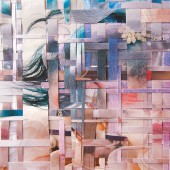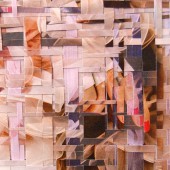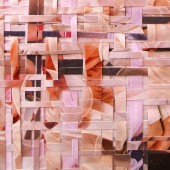Memory Fine Art Object by Juri Akiyama |
Home > Winners > #45563 |
 |
|
||||
| DESIGN DETAILS | |||||
| DESIGN NAME: Memory PRIMARY FUNCTION: Fine Art Object INSPIRATION: The act of recollection is a repetitive yet mutational process. Though re-played image in our head is based on the real-life, it is elusive and even mimicking, as the memory coexists with other memories and imaginations. This regressive journey is rather lateral and non-sequential, in which the fragments of details are uniquely bridged. On this flat map, the elusive images are held together to collectively form what one realizes as the memory: the exoskeleton of the actuality. UNIQUE PROPERTIES / PROJECT DESCRIPTION: The multilayered grid serves itself as the open-ended system. Each strip of paper is the fragment of the original image, and within the grid system the details altogether serve to blur the reconstructed image. Meanwhile, the property of paper allows thinner strips to be sawn into the wider strips, enabling more freedom in the weaving process than the typical weaving of threads. OPERATION / FLOW / INTERACTION: The piece is meant to attract close attention to its details— the dots, which are the smallest units of the image. The viewers are to look at it at a extremely close distance, emulating the distance that one takes from the familiar flatness, such as laptop screens and books. This intimacy is also the key to express the theme; therefore, it can be even touched and held, to let the people physically feel the tension that exists in this fragile object. PROJECT DURATION AND LOCATION: The project was made in April 2013 FITS BEST INTO CATEGORY: Fine Arts and Art Installation Design |
PRODUCTION / REALIZATION TECHNOLOGY: The project started with the basic idea of using a page of a commercial magazine. Through playing with paper and making some preliminary methods such as folding and cutting, it settled to the recreation and the mutation of the page and its image by using itself and its copies. SPECIFICATIONS / TECHNICAL PROPERTIES: 40cm x 28cm TAGS: Paper, Fine Art, Appropriation, Grid, Handmade, Flatness RESEARCH ABSTRACT: The piece started from associating the concept of memory with flat surface and commercial images. It soon evolved into a more comprehensive theme: the concept of information. There exists no depth in the infinite lateral exploration of the images popping up in the exoskeletal grid of lights and ink. The objective hence was realized as to heighten the awareness to what exactly that creates the image in our head and how the selection of information happens uniquely to each person to quilt a certain concept/image. The result was the delicate paper-cloth, which flips the sequential, vertical model of actuality-image relationship into the non-sequential, horizontal one. CHALLENGE: The technical challenge is the weaving process, as the paper strips are extremely fragile. They also easily slip off each other, yet making a self-sustainable piece of paper-cloth requires a certain tension among them. Conceptually, the inherently violent nature of the act of shredding an image contributed to set a certain direction to the piece, in order to avoid such impression. ADDED DATE: 2016-02-19 03:34:54 TEAM MEMBERS (1) : IMAGE CREDITS: Juri Akiyama, 2013. |
||||
| Visit the following page to learn more: http://cargocollective.com/juriakiyama | |||||
| AWARD DETAILS | |
 |
Memory Fine Art Object by Juri Akiyama is Winner in Fine Arts and Art Installation Design Category, 2015 - 2016.· Press Members: Login or Register to request an exclusive interview with Juri Akiyama. · Click here to register inorder to view the profile and other works by Juri Akiyama. |
| SOCIAL |
| + Add to Likes / Favorites | Send to My Email | Comment | Testimonials | View Press-Release | Press Kit |







